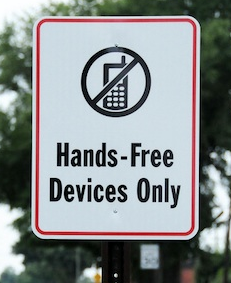Collisions Go Up After Distracted Driving Regulations Introduced
Keep your eyes on the road and your hands on the wheel: it's usually the first advice a student driver is given when learning how to drive. And yet distracted driving remains a huge problem, especially in this age of ubiquitous cellphone use.
The simple fact is - drivers that talk or text on their phones are far more likely to get into an accident.
Stop in the Name of Law
 To fight the trend, many regions have started implementing "distracted driving" laws that limit or prohibit the use of cellphones when operating a motor vehicle. But a study by the U.S. Insurance Institute for Highway Safety has found that these laws actually correlate to a higher number of accidents. New statistics released by the Calgary police back up these findings. The number of collisions actually went up last year, after Alberta introduced legislation that would fine drivers for behaving in a dangerous manner behind the wheel.
To fight the trend, many regions have started implementing "distracted driving" laws that limit or prohibit the use of cellphones when operating a motor vehicle. But a study by the U.S. Insurance Institute for Highway Safety has found that these laws actually correlate to a higher number of accidents. New statistics released by the Calgary police back up these findings. The number of collisions actually went up last year, after Alberta introduced legislation that would fine drivers for behaving in a dangerous manner behind the wheel.
Experts think this could be because, instead of curbing cellphone use when behind the wheel, the laws are causing some drivers to become sneakier about it, so that they're texting into their laps instead of looking up through the windshield. But if laws can't stop this behaviour, what can? Well, it seems technology itself may actually hold the answer. There are a growing number of apps and devices that focus on disabling a driver's ability to interact with his or her cellphone when the car is in motion.
Apps to Curb Distracted Driving
The majority of these apps are self-policing, in that the users need to recognize that they aren't always capable of fighting the temptation to fire off a quick text, and then download and install the app themselves. Still, for users who do have that self-awareness, there are a growing number of smartphone apps which use the built-in GPS to detect when the vehicle is moving, and will disable many of the phone's features until the car stops. There are also similar apps for concerned parents who want to make sure their teenagers aren't trying to text and drive at the same time.
But as the problem is becoming more recognized, there's a shift that's beginning to take control out of the user's hands. Take, for example, Origo, a prototype cellphone docking station aimed at owners of transport truck fleets who want to monitor the drivers in their employ. The driver’s cellphone must be placed in the dock before the truck will start. If the phone is used too often or removed from the cradle for too long when the truck is in motion, the vehicle will come to a full stop.
And there are other burgeoning ideas out there. Researchers at Pacific Northwest National Laboratory are working on a program that might actually be able to analyze how a user is typing (how fast, in what sort of patterns, with one hand or both, etc.) to determine whether the typist is splitting their focus between the phone and the road.
Whatever the solution, it's becoming clear that laws alone aren't enough to effectively stop distracted driving. The lure of the ringtone is just too strong for some. But as technology advances, perhaps cellphones themselves will become the key to solving the very problem that they have caused.
Remember that one of the benefits of being a safe driver is cheaper car insurance.
If you would like to get a quote on your car insurance from First Foundation or have any questions about auto insurance at all, please contact us anytime.
President of First Foundation Residential Mortgages and First Foundation Insurance. Live in Edmonton but cheer for the Riders. I have lots of kids. Follow me on Twitter @gordmccallum
